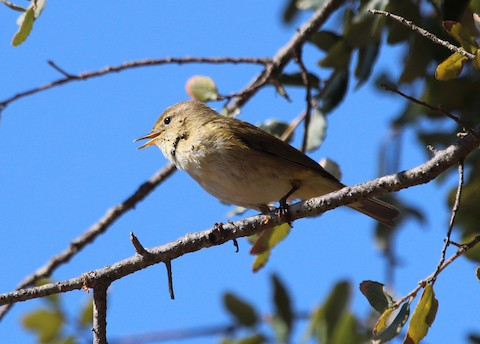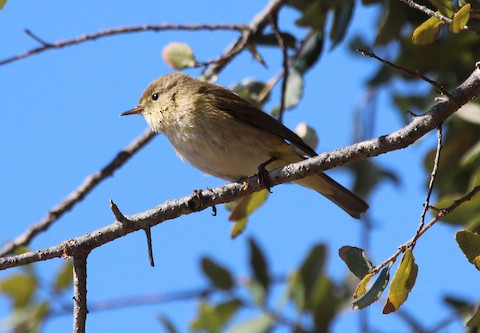
Alert Status:
Not Assessed
Population change:
Unmonitored
Unknown in the UK
Listen to Iberian Chiffchaff song:
The Iberian Chiffchaff looks very similar to the common chiffchaff, it has green/brown upper parts with slight dark wings and tail and pale buff underparts. Their head is green/brown with a visible yellow eyebrow stripe (or supercilium). It is most easily separated from the common chiffchaff by its call as it is not the same onomatopoeic ‘chiff-chaff, chiff-chaff’ song.
Average Length: 10 cm
Average Wingspan: 18 cm


This species mainly eats invertebrates which they forage for in trees and dense vegetation. In the autumn it will also eat fruit when invertebrate numbers decline.
We have a limited understanding of the breeding habits of this species, due to the fact they were thought to be the same as common Chiffchaffs for so long. The breeding season begins in April when 4-5 eggs are laid. The breeding behaviours are likely very similar to that of the common chiffchaff, but we cannot know for sure until more detailed studies are carried out.
There are not currently any significant conservation concerns for this species. However, common threats such as climate change and habitat loss may cause problems in the future. Climate change causes droughts in their African wintering grounds which reduces their food supply during the winter. Loss of suitable woodland habitats and reduction of invertebrate prey in the UK could drive decreases in this species.
If you see an Iberian chiffchaff breeding, do not report it publicly and read the guidance on the rare breeding birds panel website for how best to make a report.
The Iberian Chiffchaff was only separated from the Common chiffchaff in the early 2000s, based on DNA evidence and their distinct song.
BirdLife International (2023) Species factsheet: Phylloscopus ibericus. Downloaded from http://datazone.birdlife.org/species/factsheet/iberian-chiffchaff-phylloscopus-ibericus. Accessed: 06/11/2023
Catry, P., Lecoq, M., Araújo, A., Conway, G., Felgueiras, M., King, J. M. B., Rumsey, S., Salima, H., & Tenreiro, P. (2005). Differential migration of chiffchaffs Phylloscopus collybita and P. ibericus in Europe and Africa. Journal of Avian Biology, 36(3), 184–190. https://doi.org/10.1111/J.0908-8857.2005.03445.X
de la Hera, I., Gómez, J., Dillane, E., Unanue, A., Pérez-Rodríguez, A., Pérez-Tris, J., & Torres-Sánchez, M. (2020). Wintering grounds, population size and evolutionary history of a cryptic passerine species from isotopic and genetic data. Journal of Avian Biology, 51(9). https://doi.org/10.1111/JAV.02559
Gordo, O., Arroyo, J. L., Rodríguez, R., & Martínez, A. (2017). Inability of Biometry to Discriminate Iberian and Common Chiffchaffs during the Autumn Migration Period. Ardeola, 64(1), 49–65. https://doi.org/10.13157/arla.64.1.2017.ra4
Salomon, M., Voisin, J. F., & Bried, J. (2003). On the taxonomic status and denomination of the Iberian Chiffchaffs. Ibis, 145(1), 87–97. https://doi.org/10.1046/J.1474-919X.2003.00122.X